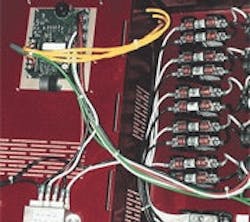Organization Prevents Panel Missteps
Our panel building process begins with some basic but vital research. The goal is to give our customers a component panel that meets their needs, keeping the cost to a minimum and allowing for future changes.
Our Project Input Output Criteria Form asks the end user to pick from a thorough list of control specifications. These specs will mold the concept design for our panel layout and cover all aspects of the machine's components—drawing formats, design review requirements, safety criteria. This also sets the proper lines of communication contacts in those respective areas.
We start with the incoming electrical criteria such as desired voltage, phases and Hertz, and we continue to the control voltage requirements for inputs and outputs. We ask customers to tell us their preferred brands of motor starters, safety relays, general relays, circuit breakers, power supplies and disconnects.
The PLC is the most important component on the panel to spec out. The entire panel will be based around it. Most companies have a preferred PLC brand due to familiarity with or training on that brand or its software. In the rare case that the end user doesn't specify a brand, we select from our own preferred line of processors.
Once the components are selected, we can start to lay out the panel and work on the prints electronically. This determines the size of the panel and what we present at our control design review. After the control design review approval, we can start to build our panel with assurance that the controls components and the layout are acceptable to the end user.
That brings us to the point where we can construct and wire our panel. We begin with the ductwork around the outside edges of the panel. All wire-way ductwork and any components that will go on the panel are checked for level and square to the panel.
Once the outside ductwork is in place, we start our inner rungs of duct. If a controls engineer has completed a layout of the panel, this is easy because the spacing measurements are already called out. When panel layouts are not available ahead of time, it's important to have all items that will be placed on the panel present to ensure the internal ductwork is placed in a manner that will leave acceptable room to access wiring points.
With the increase of available component information online over the past 10 years, we can easily find almost all items and their dimensions. This allows us to build the base of our panel upon acceptance of the design review with all ductwork and DIN rail at the same time the components are ordered.
Over the years we've made templates of many of the items we commonly use on our panels to save time for our builders. They simply put the templates where the component will go and transfer the holes. Any item that needs extra support is done by running bolts through the back of the panel to ensure correct support and to give the end user a means of swapping out the component at a later time, if needed, without having to take the panel out.
Before we can place any items on the panel beyond the duct and DIN rail, the duct must be drilled out for the enclosure bolts. Anyone who has built multiple panels probably has forgotten this at some point.
All wiring should be as neat as possible and labeled evenly. We label all motor starters, relays, circuit breakers and fuses. We use a small, handheld sticker machine for all component identification.
After our panels are completely wired, our technicians go through a panel inspection checklist to ensure the panel is ready for use. Some key questions always should be answered at the end of the build. Is the duct drilled out for the enclosure bolts? Are the motor overloads adjusted to the correct amperage? Are all terminal blocks properly labeled? And are all fuses inserted?
At the completion of our checklist, our technicians will stamp the panel with an approval stamp. This tells everyone that the panel is ready for operation.
Calvin Comstock is controls engineer at Lomar Machine (www.lomar.com) in Horton, Mich.


